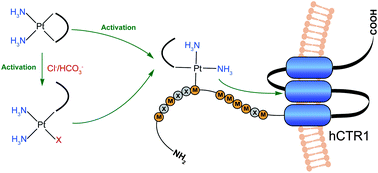Activation of carboplatin and nedaplatin by the N-terminus of human copper transporter 1 (hCTR1)
Abstract
Human copper transporter 1 (hCTR1) is a major copper uptake

* Corresponding authors
a
Department of Chemistry, The University of Hong Kong, Pokfulam Road, Hong Kong, P.R. China
E-mail:
hsun@hku.hk
Fax: +852 2857 1586
Tel: +852 2859 8974
b School of Chemistry, The University of Edinburgh, West Mains Road, Edinburgh, UK
c State Key Laboratory of Coordination Chemistry, School of Chemistry and Chemical Engineering, Nanjing University, 210093 Nanjing, P.R. China
Human copper transporter 1 (hCTR1) is a major copper uptake

 Please wait while we load your content...
Something went wrong. Try again?
Please wait while we load your content...
Something went wrong. Try again?
X. Wang, H. Li, X. Du, J. Harris, Z. Guo and H. Sun, Chem. Sci., 2012, 3, 3206 DOI: 10.1039/C2SC20738A
To request permission to reproduce material from this article, please go to the Copyright Clearance Center request page.
If you are an author contributing to an RSC publication, you do not need to request permission provided correct acknowledgement is given.
If you are the author of this article, you do not need to request permission to reproduce figures and diagrams provided correct acknowledgement is given. If you want to reproduce the whole article in a third-party publication (excluding your thesis/dissertation for which permission is not required) please go to the Copyright Clearance Center request page.
Read more about how to correctly acknowledge RSC content.
 Fetching data from CrossRef.
Fetching data from CrossRef.
This may take some time to load.
Loading related content
